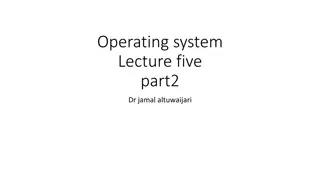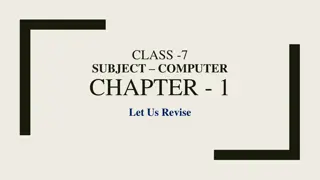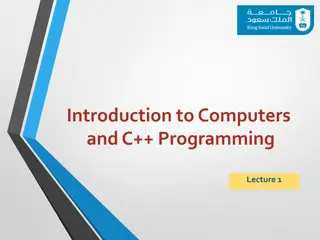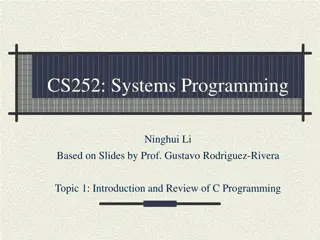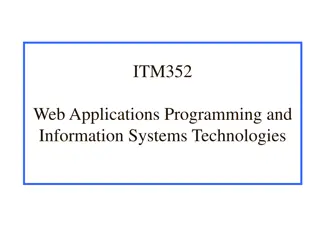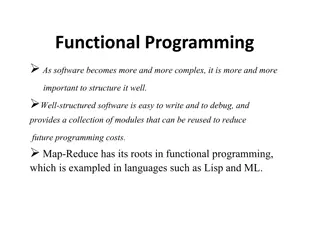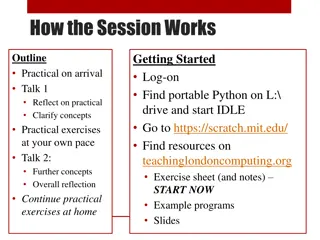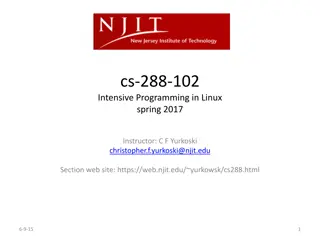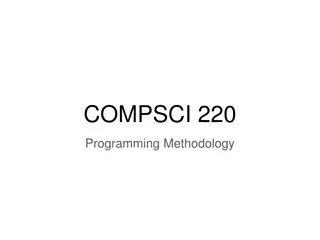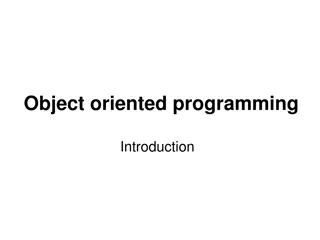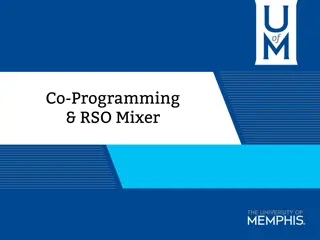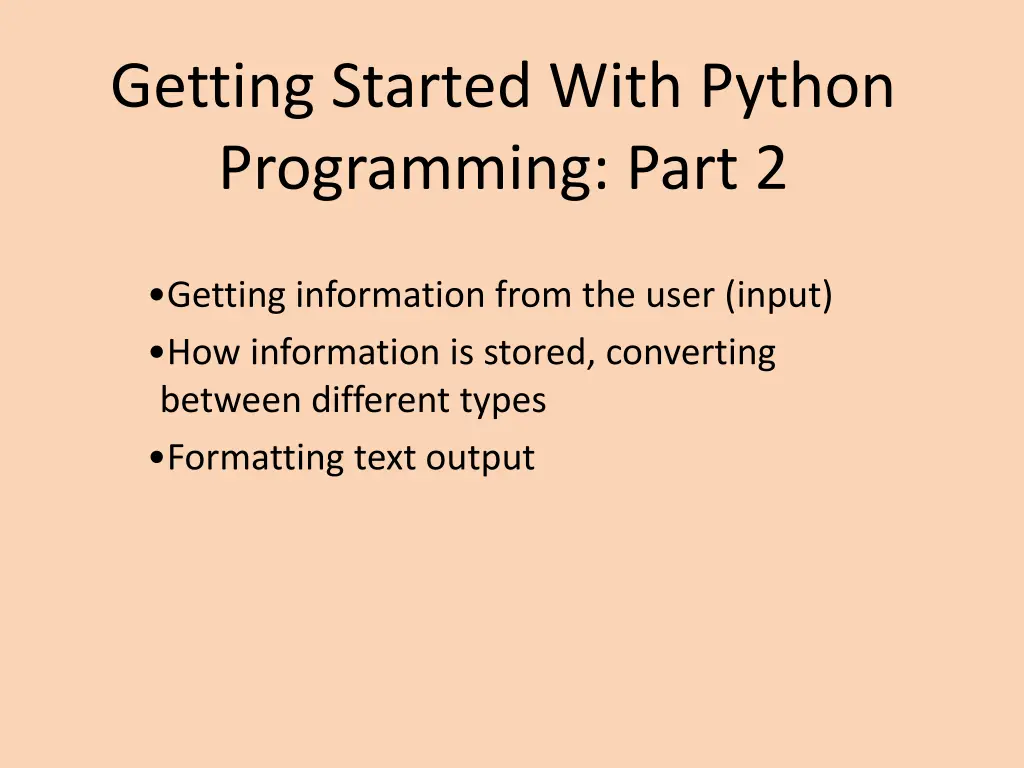
Understanding Data Storage and Input in Python
Learn how to get information from users, store data in different types, and convert between them in Python programming. Explore how information is stored in binary, converting user input into binary, storing integer and real numbers, and more. Discover the essentials of handling user input effectively and efficiently.
Download Presentation

Please find below an Image/Link to download the presentation.
The content on the website is provided AS IS for your information and personal use only. It may not be sold, licensed, or shared on other websites without obtaining consent from the author. If you encounter any issues during the download, it is possible that the publisher has removed the file from their server.
You are allowed to download the files provided on this website for personal or commercial use, subject to the condition that they are used lawfully. All files are the property of their respective owners.
The content on the website is provided AS IS for your information and personal use only. It may not be sold, licensed, or shared on other websites without obtaining consent from the author.
E N D
Presentation Transcript
Getting Started With Python Programming: Part 2 Getting information from the user (input) How information is stored, converting between different types Formatting text output
Input The computer program getting string information from the user. Strings cannot be used for calculations (information for getting numeric input will provided shortly). Format: <variable name> = input() OR <variable name> = input("<Prompting message>") Avoid alignment issues such as this Name of the full example: 8input.py print("What is your name: ") name = input() OR name = input("What is your name: ") OR print("What is your name: ", end="") name = input() James Tam
Variables: Storing Information (If There Is Time) On the computer all information is stored in binary (2 states) Example: RAM/memory stores information in a series of on-off combinations A single off/off combination is referred to as a bit Bit on off OR Byte 8 bits James Tam
Variables: Storing Information (If There Is Time) Information must be converted into binary to be stored on a computer. User enters 13 Can be stored as James Tam slide 4
Storing Integer Information (If There Is Time) 1 bit is used to represent the sign, the rest is used to store the size of the number Sign bit: 1/on = negative, 0/off = positive Format: Positive number Digits representing the size of the number (all the remaining bits) 1 bit Negative number Previous example Size of number, in this case = 13 Positive number James Tam slide 5
Storing Real Numbers In The Form Of Floating Point (If There Is Time) Sign Mantissa Exponent Several bits Several bits 1 bit Mantissa: digits of the number being stored Exponent: the direction (negative = left, positive=right) and the number of places the decimal point must move ( float ) when storing the real number as a floating point value. Examples with 5 digits used to represent the mantissa: e.g. One: 123.45 is represented as 12345 * 10-2 e.g. Two: 0.12 is represented as 12000 * 10-5 e.g. Three: 123456 is represented as 12345 * 101 Remember: Using floating point numbers may result in a loss of accuracy (the float is an approximation of the real value to be stored). James Tam
Storing Character Information (If There Is Time) Typically characters are encoded using ASCII Each character is mapped to a numeric value E.g., A = 65, B = 66, a = 97, 2 = 50 These numeric values are stored in the computer using binary Character ASCII numeric code 65 Binary code 01000001 A 66 01000010 B 97 01100001 a 50 00110010 2 James Tam
Storing Information: Bottom Line Why it important to know that different types of information is stored differently? One motivation: sometimes students don t why it s significant that 123 is not the same as the number 123. Certain operations only apply to certain types of information and can produce errors or unexpected results when applied to other types of information. Example num = input("Enter a number") numHalved = num / 2 James Tam
Converting Between Different Types Of Information Example motivation: you may want numerical information to be stored as a string (for built in string functions e.g., check if a string consists only of numbers) but also you want to perform calculations). Some of the conversion mechanisms (functions) available in Python: Format: int(<value to convert>) float(<value to convert>) str(<value to convert>) Value to convert ( ) Conversion function Converted result Examples: Name of the full example:9convert.py var1 = 10.9 var2 = int(var1) print(var1,var2) James Tam
Converting Between Different Types Of Information (2) Examples: Name of the full example: 10convert.py var1 = "100" var2 = "-10.5" print(var1 + var2) print(int(var1) + float(var2)) James Tam
Converting Types: Extra Practice For Students Determine the output of the following program: print(12+33) print("12"+"33") x = 12 y = 21 print(x+y) print(str(x)+str(y)) James Tam
Converting Between Different Types Of Information: Getting Numeric Input The input() function only returns string information so the value returned must be converted to the appropriate type as needed. Name of the full example:11convert.py # No conversion performed: problem! HUMAN_CAT_AGE_RATIO = 7 age = input("What is your age in years: ") catAge = age * HUMAN_CAT_AGE_RATIO print ("Age in cat years: ", catAge) Age refers to a string not a number. The * is not mathematical multiplication James Tam
Converting Between Different Types Of Information: Getting Numeric Input (2) # Input converted: Problem solved! HUMAN_CAT_AGE_RATIO = 7 age = int(input("What is your age in years: ")) catAge = age * HUMAN_CAT_AGE_RATIO print("Age in cat years: ", catAge) Age converted to an integer. The * now multiplies a numeric value. James Tam
Section Summary: Input, Representations How to get user input in Python How do the different types of variables store/represent information (optional/extra for now) How/why to convert between different types James Tam
By Default Output Is Unformatted Example: num = 1/3 print("num=",num) The number of places of precision is determined by the language not the programmer Sometimes you get extra spaces (or blank lines) There may be other issues e.g., you want to display output in columns of fixed width, or right/left aligned output There may be times that specific precision is needed in the displaying of floating point values James Tam
Formatting Output Output can be formatted in Python through the use of format specifiers and escape codes James Tam
Format Specifiers (If There Is Time) Format: print ("%<type of info to display/code>" %<source of the info to display>) Doesn t literally display this: Placeholder (for information to be displayed) Example (starting with simple cases): Name of the full example:12formatting.py num = 123 st = "cpsc 231" print("num=%d" %num) print("course: %s" %st) num = 12.5 print("%f%d" %(num,num)) James Tam
Types Of Information That Can Be Formatted Via Format Specifiers (Placeholder) (If There Is Time) Specifier Type of Information to display %s String %d Integer (d = decimal / base 10) %f Floating point James Tam
Formatting Effects Using Format Specifiers (If There Is Time) Format: %<width>1.<precision>2<type of information> Examples (format specifiers to format output): Name of the full example: 13formatting.p num = 12.55 print ("%4.1f" %num) print ("%5.1f" %num) print ("%3.1f" %num) print ("%3s%-3s" %("ab", "ab")) print ("%-3s%3s" %("ab", "ab")) 1 A positive integer will add leading spaces (right align), negatives will add trailing spaces (left align). Excluding a value will set the field width to a value large enough to display the output 2 For floating point data only. James Tam
One Application Of Format Specifiers (If There Is Time) It can be used to align columns of text. Example (movie credits, tabular or financial information) James Tam
Section Summary: Formatting Output (If There Is Time) How to use format specifiers (field width, precision) to format output James Tam
Escape Codes/Characters The back-slash character enclosed within quotes won t be displayed but instead indicates that a formatting (escape) code will follow the slash: Escape sequence Description Alarm: Causes the program to beep. \a Newline: Moves the cursor to beginning of the next line. Tab: Moves the cursor forward one tab stop. \n \t Single quote: Prints a single quote. \' Double quote: Prints a double quote. \" Backslash: Prints one backslash. \\ James Tam
Percent Sign1 (If There Is Time) If no format specifiers are used then simply enclose the % within the quotes of a print() statement print("12%") 12% If format specifiers are used within a call to print() then use one percent sign to act as an escape code for another percent sign to follow print("%f%%" %(100)) 100.000000% James Tam 1 Since the question inevitably comes up each term I m answering it here
Escape Codes (2) Program name: 14formatting.py print ("\a*Beep!*") print ("hi\nthere") print ('it\'s') print ("he\\y \"you\"") James Tam
Escape Codes: Application It can be used to nicely format text output (alignment output, provide separators within and between lines) Program example: 15formatting.py firstName = "James" lastName = "Tam" mobile = "123-4567" print("Last name:\t", lastName) print("First name:\t", firstName) print("Contact:\t", mobile) Escape codes for aligning text is even more valuable if the width of a field (data to be displayed) is variable e.g., comes from user input or a text file. James Tam
Section Summary: Escape Codes How to use escape codes to format output James Tam
Extra Practice Traces: Modify the examples (output using format specifiers and escape codes) so that they are still valid Python statements. Alternatively you can try finding some simple ones online or from a textbook. Hand trace the code (execute on paper) without running the program. Then run the program and compare the actual vs. expected result. Program writing: Write a program the will right-align text into 3 columns of data. Write a program the will left-align text into 3 columns of data. James Tam
After This Section You Should Now Know How to format output through: The use of format specifiers Escape codes James Tam


